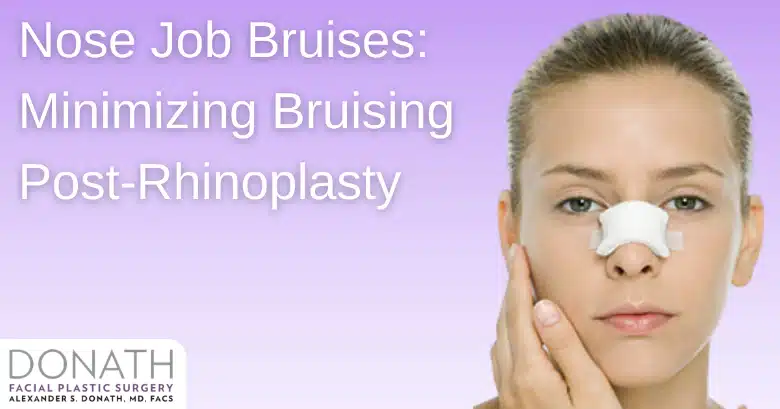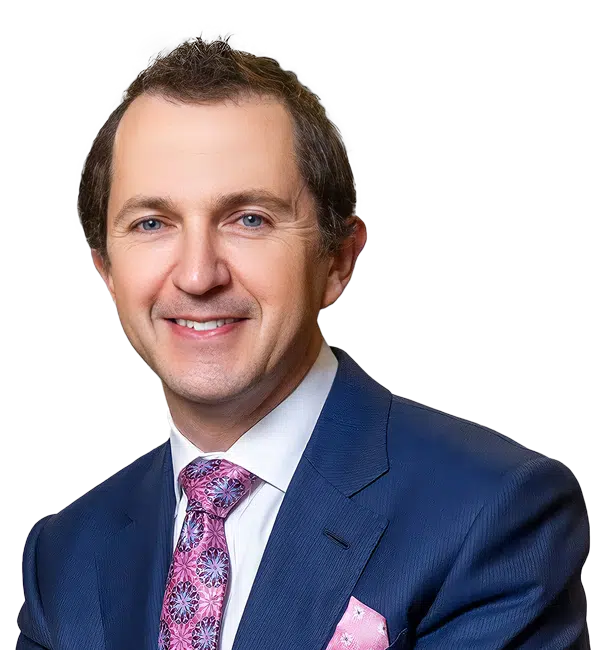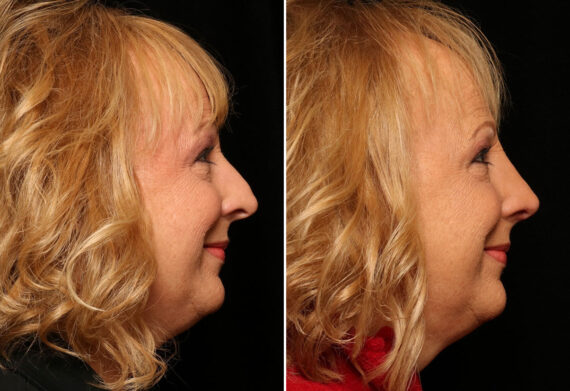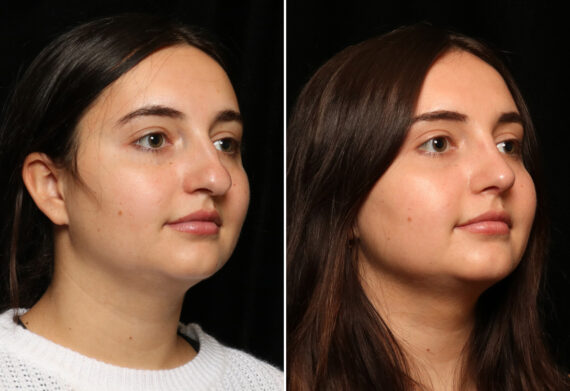
Minimizing Bruising in Rhinoplasty
When it comes to surgery, there are some inevitable side effects that are caused by the trauma of the operation. Bruising is an extremely common phenomenon following surgery, particularly rhinoplasty. This bruising is concentrated on the nose and the eye area and can take quite a while to fade, making many patients uneasy about leaving the house during recovery. While bruising cannot be entirely avoided following rhinoplasty, many patients are understandably interested in minimizing the bruising as much as possible. But is there a way to help prevent bruising as a patient? And can you help accelerate the rate of recovery for bruising that does occur?
Causes of Bruising
Bruising is caused by blood vessels breaking or tearing and leaking blood into the tissue. Bruising is visible under the skin and fades slowly over time. The trauma from nasal surgery often causes bruising in rhinoplasty that takes time to resolve. In the past, techniques used in preparing the nose for recovery, such as nasal packing, could actually make bruising worse, but modern techniques are much less traumatic to the patient and to the nose. While it is difficult to predict how much bruising each patient will have prior to the surgery, there are some ways to help prevent and treat post-operative bruising.
Pre-Operative Prevention
The best way to help prevent bruising before your surgery is to make sure you are keeping yourself as healthy as possible and heed any restrictions from your surgeon. For example, patients are not allowed to smoke or drink prior to surgery, and many over-the-counter medications, prescriptions, and even herbal supplements are not allowed, as they can be a safety risk and compromise healing. Be sure to disclose all the blood thinning medications and supplements you take to your surgeon, even if you only take them intermittently or they do not seem important to mention.
The Roles of the Surgeon & Customization
Rhinoplasty is a complex procedure, and the surgeon’s skill has an impact on the healing process as well as on the results. Precision in surgical technique, experience, and the surgeon’s own style all have an impact on the side effects patients can experience. Additionally, some patients are simply more prone to bruising than others.
Because rhinoplasty is a custom procedure, there are many different techniques that may be used to yield the desired results for each patient. Some patients require extensive changes that involve breaking and resetting the bone, manipulating nasal cartilage, and altering the framework of the nose, while others only require simple changes to the nasal tip.
Techniques such as fracturing the nasal bones are naturally more prone to extensive bruising after the procedure, but Dr. Donath is able to minimize or prevent this in almost all cases. Some people believe that the “closed” technique (no external incisions) produces less bruising than the “open” method (small incision between the nostrils) of rhinoplasty, however, there are major benefits of the open technique, and it is appropriate for many different patients.
Post-Operative Prevention and Treatment
The first rule for reducing the side effects of the surgery, including bruising, is to follow all of your surgeon’s instructions as closely as possible. This will help hasten the healing process and keep you more comfortable during recovery. Avoiding excessive handling of the nose will also help keep bruising to a minimum.
Homeopathic remedies can help reduce bruising during the recovery period. Ice used continuously for the first few days is helpful, as is drinking pineapple juice (containing bromelain) and using arnica products. Dr. Donath also formulates the last piece of his exclusive Rapid Recovery Techniques into each patient’s recovery plan. At a patient’s one-week post-operative appointment, they will be treated with the V-Beam Laser to help accelerate the bruising/healing process. The V-Beam Laser treatment delivers an intense but gentle burst of light to the skin that is absorbed by the blood vessels in the dermis. These blood vessels are reabsorbed by the body, allowing for a cleaner, more refreshed appearance.
Minimizing Bruising In Rhinoplasty
There are some habits that can negatively influence the healing process, including smoking and drinking. Resuming these habits before recovery is complete can compromise healing and safety, slowing down the resolution of typical rhinoplasty bruising timeline, and even compromising results in some cases.
Follow Your Surgeon’s Instructions
It is important to follow the surgeon’s instructions while recovering from a rhinoplasty. It is also important to keep in mind that bruising may occur as a result of surgery, which can make you feel self-conscious during the recovery process. But this goes away and you can look forward to the results.
Keep Your Head Elevated
When you’re under general anesthesia, your blood flow decreases. This means that the skin may not be able to get enough oxygen, which can make bruising more likely. Elevating your head can help reduce this risk by improving blood flow to your brain and allowing your blood vessels to circulate more efficiently.
Use Cold Compresses
Applying a cold compress can help to reduce swelling. The compress should be applied as soon as possible after surgery and it is recommended that it stay on for at least 20 minutes. This can be repeated over the course of the day if needed.
Sleep It Off
The best way to minimize bruising in rhinoplasty is to get plenty of sleep and take it easy for a few days. This may seem like an obvious tip, but it’s important for the healing process.
Stay Hydrated
It’s important to stay hydrated before and after surgery. This will help the body heal faster and decrease the chance of bruising. You should drink enough water in the week leading up to surgery, as well as for two weeks following surgery.
Drinking plenty of fluids will also help prevent constipation, a common side effect after any type of procedure.
Use Creams to Help Bruises Heal
Apply a thick layer of petroleum jelly to the nose and around the eyes. This is a great way to minimize bruising because it seals in moisture and helps your skin heal. Take recommended medications that can decrease inflammation, swelling, and bruising.
Don’t Smoke
Smoking is a common cause of bruising in rhinoplasty. Tobacco and other substances in cigarettes can reduce the blood’s ability to clot. It is recommended that you stop smoking one month before your surgery, as well as during the recovery period. The healing process will be faster and there will be less chance of bruising.
Be Patient
The first two weeks are typically the most challenging, but everyone is different and it can take up to 6 weeks before your nose is back to normal. Do not press on the bridge of your nose or pick at any scabs, which could cause more bleeding.
Remember, things may be worse before becoming better. The black eyes disappear, and the swelling fades with time. Following aftercare can help to speed up your recovery to make your healing experience better.

How Long Does Bruising Last?
Unfortunately, when it comes to bruising and rhinoplasty recovery, patience is often required. The time it takes bruising to heal after rhinoplasty depends on a number of factors, including the extent of the initial bruising and the quality of aftercare. Even most people without Dr. Donath’s laser rhinoplasty treatment, see the resolution of bruising within two to three weeks on average. Once bruising has begun to fade, it is usually possible to cover them up with makeup, should you feel self-conscious about going out with visible bruising. Remember, you only have to deal with bruising for a few weeks, but your results will last a lifetime. Give yourself a break and let the body heal itself on its own time.
Advice from an Expert
If you would like to discuss the possibility of rhinoplasty with a qualified plastic surgeon, then it may be time to schedule your consultation. Because the procedure is so complex, it is strongly advised that you meet only with Board-Certified Facial Plastic Surgeons who specialize in rhinoplasty, like Dr. Donath. Dr. Donath has a passion for rhinoplasty and has proven his ability to help patients of diverse backgrounds achieve natural-looking, custom results. To schedule a consultation with Dr. Donath, call Donath Facial Plastic Surgery at (513) 891-5438 today or visit this link and fill out the online form.
Frequently Asked Questions about Rhinoplasty
Still want to know more about Rhinoplasty, here are our frequently asked questions.
Rhinoplasty is a procedure that is done to improve the appearance and functionality of the nose. It can be performed for cosmetic purposes or to help fix structural problems with the nose, such as breathing difficulties. The most common rhinoplasty procedures are Rhinoplasty nasal tip-tip surgery, Nasal Reduction surgery, and Nasal Deformity surgery.
If you believe that your nose is too large, it’s important to consult with a Board-Certified Plastic Surgeon before pursuing any type of surgery. In most cases, rhinoplasty will successfully reduce the size and/or shape of your nose without making it look unnatural.
Yes, rhinoplasty can make your nose smaller. The procedure is typically done in one of two ways: either reducing the size of the cartilage and bone or removing a section of the tip. This will allow for a narrower and shorter nose.
Surgery always comes with some degree of risk and rhinoplasty is no exception. Some risks include:
Swelling: Swelling can persist for up to six months following the surgery. To help alleviate this issue, ice packs can be placed in the area for 20 minutes every hour for the first three days after surgery.
Bruising: Bruising is to be expected with any surgery and usually resolves on its own within a week or two. However, if you experience excessive bruising or bleeding, contact your surgeon immediately as this may indicate an underlying problem.
Breathing Problems: Breathing problems are not common but could occur during or after the operation if not addressed in time.
Most patients will notice a significant improvement in their breathing, appearance, and self-confidence following rhinoplasty. The healing process can take as little as three weeks and up to six months, but you should be able to see some results immediately following your surgery. It’s very important not to blow your nose for the first two weeks after your procedure because the inside of the nose is still fragile and could bleed easily. You may also experience some bruising around your eyes or on your upper lip where the surgeon will have made incisions. This is normal and should go away within a few days or so.
Getting a nose job is a big decision and one that should not be taken lightly. As with any surgery, there are risks involved. Your child will also need to be in good health and have realistic expectations when considering surgery. It’s best to consult with a Board-Certified Plastic Surgeon for more information and recommendations on rhinoplasty for children.
Although it’s always recommended to consult with a board-certified physician for more information before getting your nose done at such an early age, we can’t say definitively if it’s too early or too late for someone who is eighteen years old. A lot of factors go into the decision-making process of getting rhinoplasty surgery including how long you’ve been unhappy with your nose, how much time has passed since the issue started bothering you, and other personal preferences of yours that may affect your happiness level.
Recovery time varies depending on the type of surgery and how extensive it is. A simple nose job surgery might only take a few days, while a more extensive surgery might require weeks to recover. Doctors usually give their patients general instructions for care, but you should consult with your rhinoplasty surgeon and follow these instructions closely. You may need to be out of work for at least one week after the procedure, depending on what kind of job you do. If you plan on traveling or going back to school too soon after rhinoplasty, you could find yourself struggling to cope with the pain from flying or sitting in class all day.
Avoiding things that can aggravate the healing process is important. Some things you should avoid after having a rhinoplasty include smoking or exposing your nose to secondhand smoke, exposing your nose to extreme heat and cold, applying makeup, eating spicy foods and rubbing your nose, and rubbing or touching your nose too much.


